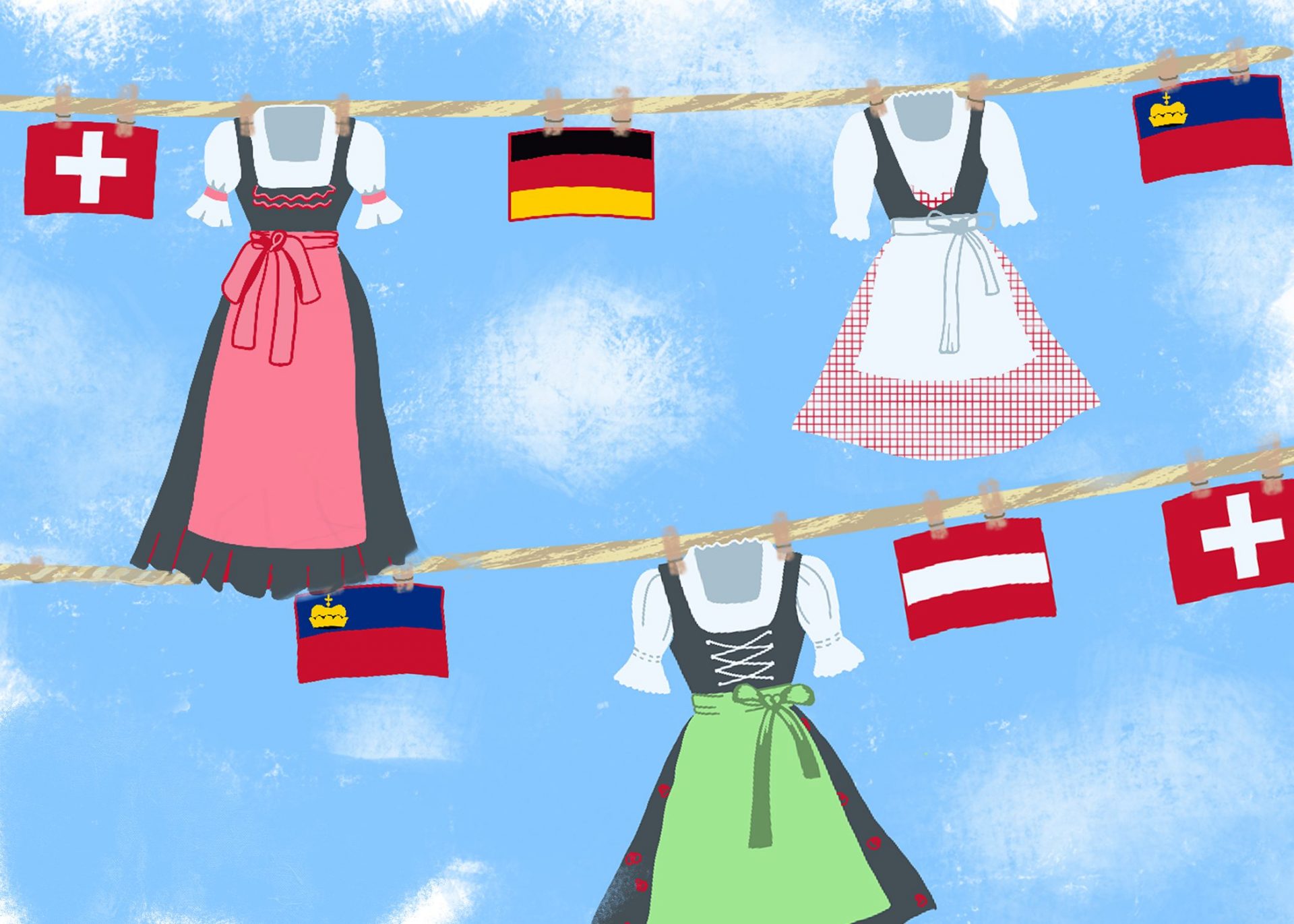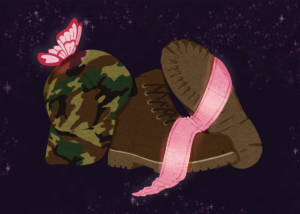It is Oktoberfest, and all around college campuses, Amazon packages are arriving with beer-maid dresses that students will wear once or twice to an Oktoberfest darty. They will feel sexy in their German dresses with low-cut blouses that they use as excuses to drink excessive amounts of beer. Meanwhile, I cannot help but see them as emblematic of my reckoning with how I connect with my cultural heritage and my identity as a first generation Austrian-American.
The dress—with its blouse, apron, and corseted top—is undoubtedly iconic. However, it is often called anything but its real name: dirndl. Even rarer is for people to know anything about the cultural and historical importance of the dress past its association with Oktoberfest. So it is undoubtedly difficult for people donning polyester replicas of the dress to understand why the dress holds such a fraught position within not just my identity and heritage, but the cultures that it comes from.
Thus, this Oktoberfest, I invite you to come along with me. I invite you not just to understand what you are wearing for this celebration, but to see why the dress, as a cultural object, is so tricky for me to navigate. I do not ask that you stop wearing it—though I may suggest purchasing one made of better quality—but rather to understand why this dress is complicated before you decide to wear it yourself.
I first noticed the ignorance surrounding dirndls when I realized that many people in the United States see the dirndl as specifically a traditional German dress. In reality, however, the dress is Austro-Bavarian, stemming from the culturally distinct German speaking regions impacted by the Alps. The constant conflation of the three due to their shared language and stereotypes within American culture often led me to feel as though no one really cared about my culture and where my family was from.
Further straining my relationship with the dirndl, people often see it as intrinsically tied to Oktoberfest. This, however, is quite false. While the exact origins of the dirndl are debated, the dress was worn by urban and rural Austro-Bavarians alike for all sorts of occasions, from agricultural labor to everyday fashion, and even to church, the opera, or weddings. In fact, Oktoberfest is a purely Bavarian festival that is not celebrated by any other German or Austrian regions.
But despite not being the American vision of a dirndl-wearer, dirndls have always been in my life. I wore a classic Ausseer dirndl for my preschool photo day, and my sister allegedly refused to wear any other dress for the first couple years of her life. My grandmother—who was raised in Bad Aussee, where dirndls are still commonly worn—taught me the rich history of the dirndl as a cultural item. Different regions had access to different materials and fashions, so based on the cut, color, material, and embroidery, one can tell where a dirndl—and potentially its wearer—is from. For example, the classic Ausseer dirndl, from Bad Aussee, always has a pink skirt, a purple apron, and a green bodice with a sloping cut rather than the Bavarian balcony cut. My grandmother taught me that a dirndl is not a dirndl unless there are two seams on the back curving from your shoulder blades to the small or your back.
This is what has made it so devastating to see the mass-market dirndls that are common in the United States. They disregard the rich cultural and geographic diversity of the dress and the history and traditions that come with it. They use a generic cut with no cultural significance and then continue to insult the dress by making it too short and the blouse too revealing. The dress, rather than being a reflection of the cultural practices of a specific people, becomes a culturally homogenized sex symbol that erases its own origin.
I continued to wear the dirndl because it felt like a concrete way to connect to my identity as an Austrian. Yes, I spoke the language. Yes, I was a passport-holding citizen. Yes, I regularly went back to see my cousins. But I still felt alienated from Austria. There was nothing that made me visibly or outwardly Austrian to the people around me. The dirndl was a way that I could unquestionably show that national identity.
But I slowly began to realize the difficulty of the Austrian national identity and that the dirndl is more than a way for me to connect with my mother’s family. Austrian nationalism famously contributed to the rise of Nazism and was complicit in the genocide of Jewish people and other populations during the Second World War. This fact brings a lot of shame to Austrian people and led to the shunning of nationalistic symbolism—and rightfully so. In Austria, it is hard to show national pride without bringing up questions of how nationalism has contributed to discrimination and genocide. Thus, it is difficult to celebrate my Austrian heritage. As an Austrian who lives in America where heritage and country of origin is often glorified, I had to come to terms with the fact that the symbols I use to feel close to my family may well be seen as conservative or even far-right by those I want to connect with.
Specifically, the dirndl as a national symbol has a complicated history during World War II. After his annexation of Austria and with his desire to create the idea of “German superiority,” Hitler searched for a way to create a Pan-German national identity. This identity revolved around strict and gendered familial structures, rural domesticity, and aryan “perfection.” Thus, Hitler began to select the historical and cultural artifacts that he believed promoted these values and could represent the German “race.” He chose the dirndl as the clothing of the perfect German woman, of female farm work and domesticity, and appropriated it as a Pan-German Nazi symbol. In order to keep the dress “pure,” he banned non-aryan women from wearing the dress, turning the dress into an active symbol of privilege and oppression.
The dress has regained popularity at different times and rates in the regions it is originally from. It is common to stumble across someone in a dirndl in Munich or Bad Aussee, and it is not difficult to spot other traditional clothing at the Salzburger Festspiele. According to my mother and friends from her generation, it has become cooler to wear parts of the dress and other traditional clothing alongside more modern clothing. However, the dress has yet to fully lose the ultra-conservative and nationalist image it gained during the Nazi era.
But this history has led to a new—and in my eyes positive—movement to reappropriate the dirndl. Across different communities, people who would have once been arrested for wearing a dirndl under the Nazi regime are beginning to wear it and change it to spit in the face of fascism. People from German ethnic minorities and Jewish communities have begun—or rather continued—wearing the dress as a symbol of persistence and survival in the face of historic discrimination. Afro-Bavarian designers are creating dirndls with traditional African prints in an effort to subvert its racist past. This knowledgeable appropriation of the dirndl allows people to reclaim the dress and create a new, positive meaning for it.
Even with such a complicated history and despite the many false perceptions, I have still decided to wear the dirndl I inherited from my grandmother. I wear it as an homage to the women who came before me. I wear it with the knowledge that I cannot opt out from the history of Austria, but rather that I must understand it and work to repair the harms my ancestors were complicit with. I wear it as a reminder that we cannot repeat the past. I wear it to signal that the far-right cannot continue appropriating this dress for hate. I wear it knowing that so many people did not have access to this dress and that wearing it can be an act of rebellion, especially as a queer person.
As someone who is not Bavarian, I cannot dictate how people celebrate Oktoberfest. In fact, many Bavarians support people wearing dirndls and lederhosen—the male counterpart—to festivities. But wearing this dress is far more complicated than buying it online and throwing it on to go drink beer. The dress has troves of misconceptions, culture, and complicated history tied into it. Before wearing one, consider what it is you are putting on. Consider why you are wearing it and whether you understand the implications. And then, tie your apron, drink some beer, and remember to say “prost” instead of “cheers.”





